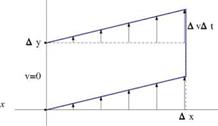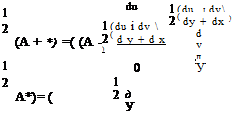Vorticity Versus Strain Rate in 2-D
Consider a rectangular particle of initial size (Ax, Ay) near the wall y = 0. On the upper edge the velocity is u = Au. Equivalently, this corresponds to moving with a particle located at (0, 0) in a velocity field where v = 0. After a short time At the particle is sheared and takes the shape of a parallelogram. The strain rate is defined as є1і2 = limAy^0 Ay = &y. Similarly, considering a velocity field with u = 0 and upon superposition with the previous flow field, one finds the following strain rate, Fig.8.3
du dv
£1,2 = £2,1 = +
dy dx
|
|
||
|
|||
|
|||
|
|||
|
|||
|
|||
|
|||
|
|||
|
|||
|
|||
|
|||
|
|||
|
|||
|
|||
|
|||
|
|||
|
|||
|

Note: any square matrix A can be decomposed uniquely into the sum of a symmetric and antisymmetric matrices
![]() A = 1 (A + A*) + 1 (A – A)
A = 1 (A + A*) + 1 (A – A)
where A* is the transposed of A. Hence
 |
|
|
|
|
|
|
|

![]()
Therefore
u(x + Ax, y + Ay, t)
v(x + Ax, y + Ay, t)
general 2 – D motion
 |
|
|
|
![]()












